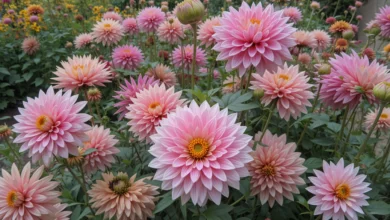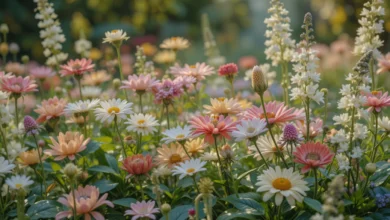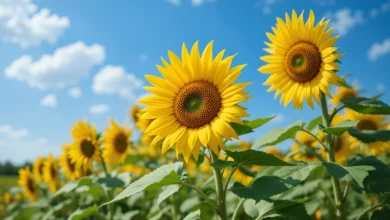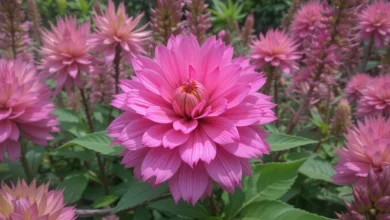How to Grow and Care for Gerbera Daisies in Your Garden

Gerbera daisies are one of the most vibrant and colorful flowers you can grow in your garden. Known for their large, daisy-like blooms in shades of pink, orange, yellow, and red, gerberas add a cheerful touch to any space. These beautiful flowers are perfect for gardens, flower beds, or containers, and they thrive with a little care and attention. If you’re looking to grow and care for gerbera daisies, this guide is for you!
In this article, we’ll walk you through everything you need to know about growing gerbera daisies, from selecting the right location to watering, fertilizing, and dealing with common problems. Whether you’re a beginner gardener or someone with a green thumb, these tips will help you get the most out of your gerbera daisies.
Why Choose Gerbera Daisies?
Gerbera daisies are not just pretty to look at. They also offer several benefits:
- Colorful Blooms: Gerbera daisies come in a variety of bright colors, including yellow, orange, pink, red, white, and purple. They can brighten up any garden or home.
- Easy to Grow: With the right conditions, gerberas are relatively easy to grow and maintain.
- Versatile: They can be grown in the ground or in containers, making them perfect for both large gardens and small patios or balconies.
- Attract Pollinators: These flowers attract bees, butterflies, and birds, which help your garden thrive.
When to Plant Gerbera Daisies
Gerbera daisies are warm-weather plants, so the best time to plant them is when the danger of frost has passed. For most gardeners, this means planting them in the spring after the last frost.
- Best Planting Time: Wait until the soil has warmed up, usually when daytime temperatures are consistently between 70°F to 75°F (21°C to 24°C).
- Planting Location: Choose a sunny spot with well-drained soil, as gerbera daisies need at least 6 hours of direct sunlight each day.
Choosing the Right Location for Gerbera Daisies
Gerbera daisies are sun-loving plants that need plenty of sunlight to grow strong and produce vibrant blooms. Here are a few things to keep in mind when selecting the location for your gerbera daisies:
- Full Sun: Gerbera daisies need full sun for at least 6 hours a day. They thrive in bright, sunny spots where they can soak up the light.
- Well-Drained Soil: The soil must be well-draining because gerberas don’t like sitting in wet, soggy soil. If your soil is heavy or clay-like, consider mixing in organic matter like compost to improve drainage.
- Protection from Strong Winds: Gerbera daisies can get top-heavy as they grow, so it’s a good idea to plant them in an area where they are protected from strong winds that could damage the plants or break their stems.
How to Plant Gerbera Daisies
Once you’ve chosen the right location for your gerbera daisies, it’s time to plant them! Follow these simple steps to ensure that your plants get off to a great start:
1. Prepare the Soil
Before planting, make sure the soil is loose and well-drained. If your soil is heavy, you can improve drainage by adding organic material like compost or peat moss. Gerberas prefer slightly acidic soil with a pH between 6.0 and 6.5.
2. Dig a Hole
Dig a hole that is about 2 inches deeper and twice as wide as the root ball of the gerbera daisy. This will give the roots plenty of space to spread out and grow.
3. Plant the Gerbera Daisy
Place the gerbera daisy into the hole, making sure the top of the root ball is level with the surrounding soil. Gently fill in the hole with soil, packing it lightly around the roots. Water the plant thoroughly after planting to help settle the soil.
4. Watering
Water the plant deeply after planting, but avoid making the soil too wet. Over-watering can lead to root rot, so be sure to let the soil dry out slightly between waterings.
Caring for Gerbera Daisies
Once your gerbera daisies are planted, it’s important to take care of them properly. Here are some essential care tips to help your flowers thrive:
1. Watering
Gerbera daisies like their soil to be moist but not soggy. Water them regularly, especially during dry spells, but make sure the water drains well. Avoid getting the leaves or flowers wet when watering, as this can encourage mold or mildew. Water the soil directly at the base of the plant.
- Tip: Use a soaker hose or drip irrigation system to water the base of the plant without getting water on the flowers or leaves.
2. Fertilizing
To keep your gerbera daisies healthy and blooming, they need regular feeding. Use a balanced fertilizer (such as 10-10-10) or one that’s specifically formulated for flowering plants.
- When to Fertilize: Start fertilizing when the plant begins to grow in the spring and continue every 4 to 6 weeks during the growing season. Reduce or stop fertilizing in the fall when the plant is preparing for dormancy.
- Tip: Use a slow-release fertilizer to provide nutrients over time and avoid overfeeding your plants.
3. Pruning
Pruning helps your gerbera daisies maintain a tidy shape and encourages new growth. Remove dead or spent flowers by cutting them back at the base of the stem. This will not only improve the plant’s appearance but also encourage more blooms.
- Tip: Prune your gerberas regularly to remove damaged or wilting leaves and flowers.
4. Deadheading
Deadheading is the process of removing dead or faded flowers from the plant. This encourages the plant to produce more blooms and keeps it looking neat. Simply cut the dead flowers off at the base of the stem.
5. Protecting from Pests and Diseases
Gerbera daisies can be prone to pests like aphids, spider mites, and whiteflies. They may also be affected by fungal diseases like powdery mildew or root rot if they are overwatered.
- How to Prevent Pests: Regularly inspect your plants for signs of pests and treat them with insecticidal soap if needed. Ensure that your plants are getting the right amount of water and sunlight to keep them healthy.
- How to Prevent Diseases: Avoid watering the leaves and flowers, and make sure your gerberas are planted in well-drained soil to prevent waterlogged conditions that encourage disease.
Overwintering Gerbera Daisies
Gerbera daisies are perennials, but in cold climates, they may not survive the winter outdoors. In colder regions, you may need to bring them indoors during the winter or dig up the plants and store the tubers.
How to Overwinter Gerbera Daisies:
- In Cold Climates: Dig up the tubers and store them in a cool, dry place over the winter. You can plant them again in the spring when the weather warms up.
- In Warmer Climates: If you live in a region with mild winters, you can leave your gerbera daisies outside, but it’s a good idea to cover them with mulch or a frost blanket to protect them from frost.
Common Problems with Gerbera Daisies
Like all plants, gerbera daisies can face challenges. Here are some common issues you may encounter:
1. Yellowing Leaves
If your gerbera daisy’s leaves are turning yellow, it could be a sign of overwatering, nutrient deficiencies, or pests. Check the soil moisture and adjust your watering schedule. You may also need to fertilize to correct any nutrient deficiencies.
2. Lack of Blooms
If your gerbera daisies aren’t blooming, it could be because they aren’t getting enough sunlight, or they may not be receiving enough nutrients. Make sure they are getting 6–8 hours of sunlight per day and are being fertilized regularly.
3. Wilting Flowers
Wilting flowers could be a sign of heat stress, overwatering, or a pest problem. Ensure that your gerberas are planted in a location with good airflow and that the soil is draining properly.
Conclusion
Gerbera daisies are vibrant, colorful flowers that can brighten any garden with their stunning blooms. By following the tips for planting, watering, fertilizing, and caring for your gerberas, you can enjoy these beautiful flowers year after year. Whether you grow them in the garden or in containers, these easy-to-care-for flowers are sure to add a touch of elegance and charm to your outdoor space.




